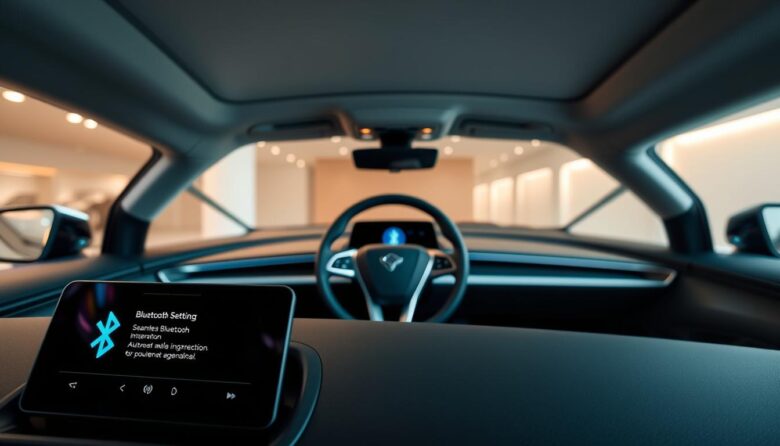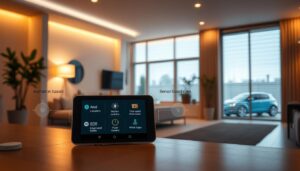Drivers often juggle multiple tasks when entering their vehicle—starting the engine, adjusting mirrors, and manually connecting their phone to the sound system. This routine creates unnecessary distractions. Modern AI-driven solutions eliminate these steps by creating instant wireless links between smartphones and vehicle interfaces.
Advanced systems use proximity sensors and machine learning to detect when users approach their vehicles. These tools activate pairing protocols automatically, establishing connections within seconds. Voice commands and steering wheel controls then provide hands-free access to navigation, music, and calls.
Over 500 vehicle models now support this intelligent integration. The technology relies on secure communication bridges between mobile apps and infotainment systems. Sensors identify registered devices, prioritizing frequently used phones for faster linking.
AI adapts to individual habits, learning preferred departure times and frequently visited locations. This personalization ensures connections activate precisely when needed. Drivers maintain focus on the road while staying seamlessly connected to their digital ecosystem.
Enhancing Your Driving Experience with AI Bluetooth Automation
Modern vehicles now act as extensions of our digital lives, merging convenience with cutting-edge technology. AI-powered connectivity eliminates tedious setup routines, allowing drivers to focus on what matters most—safety and comfort. These systems recognize your habits, from morning commutes to weekend road trips, delivering personalized interactions without manual input.
Benefits of Intelligent Device Linking
Smart ecosystems predict driver preferences, syncing playlists, navigation routes, and communication tools instantly. Voice-activated features let users manage calls or adjust media volume through simple commands. This hands-free approach reduces distractions while keeping essential functions accessible.
Simplifying Daily Travel Routines
Advanced systems prioritize frequently used apps, cutting time spent searching for settings. A stable connection ensures uninterrupted access to streaming services and real-time traffic updates. Security protocols safeguard personal data during wireless transfers, balancing convenience with privacy.
These innovations transform mundane drives into streamlined experiences. By learning schedules and preferences, AI creates tailored environments that adapt to individual needs. Drivers enjoy effortless control over their digital world, making every journey safer and more enjoyable.
Getting Started with Android automation Bluetooth car Technology
Setting up intelligent vehicle connectivity begins with verifying system compatibility. Over 500 modern vehicles support this technology, with new models joining regularly. Users should first consult their manufacturer’s compatibility list to make sure their device and infotainment system meet requirements.
Hardware & Software Requirements
Vehicle systems must support wireless communication protocols for seamless pairing. On the phone side, ensure it runs the latest operating system version and has adequate storage for the required application. Updated drivers enable faster recognition and stable links between devices.
Step-by-Step Activation Process
Download the manufacturer-approved app and follow the display instructions for initial setup. Establish a manual connection first to create a reference profile. Configure location-based triggers in the app to activate links when approaching the vehicle.
Security remains critical during setup. Enable encryption to protect personal data during wireless transfers. Test the system multiple times to refine connection timing—most setups stabilize within three attempts. If issues persist, follow on-screen prompts to troubleshoot.
This way of integrating devices ensures drivers spend less time configuring and more time enjoying streamlined journeys. Regular software updates maintain optimal performance as technology evolves.
Seamless Device Integration and App Connectivity
Modern drivers expect their digital ecosystems to work in harmony. Intelligent systems now bridge smartphones and vehicle interfaces through unified communication channels. This allows instant data transfers and precise control over apps without manual configuration.
Connecting Your Phone and Car Systems
Professional tools like AutomateIT Pro use conditional logic to activate specific functions. For example, music apps launch only when linked to a vehicle’s audio system and charging port. This prevents accidental activation with other nearby devices.
Setup involves creating unique profiles for different infotainment systems. These configurations ensure consistent performance across various manufacturers. Advanced protocols maintain stable connections even when handling multiple data streams simultaneously.
Managing Multiple Bluetooth Devices
Smart prioritization algorithms automatically switch between audio outputs. Vehicle speakers take precedence during drives, while headphones reactivate when exiting. Systems prevent interference by managing connection protocols for each paired device.
Troubleshooting features resolve conflicts between primary and secondary gadgets. Diagnostic tools identify signal overlaps or compatibility issues. Most problems fix themselves through automatic reconnection cycles and profile optimization.
Leveraging Voice Commands, Media, and Navigation Features
Today’s drivers demand intuitive control over their digital environment without compromising safety. Advanced voice recognition systems now bridge this gap, transforming how users interact with their devices while traveling.
Integrating Voice Command Assistance
Natural language processing enables drivers to manage calls, messages, and entertainment through spoken instructions. Say “Answer the call” or “Play messages” to stay connected hands-free. Systems recognize variations in phrasing, adapting to regional accents for reliable performance.
Voice controls extend beyond basic functions. Users can skip podcast episodes or jump to specific audiobook chapters using precise commands. The display shows simplified menus during interactions, reducing visual clutter while driving.
Enhancing Media Streaming and App Control
Intelligent systems learn listening habits to queue preferred music or podcasts automatically. Commands like “Play workout mix” trigger personalized playlists from streaming platforms. Media controls adjust volume or switch sources without touching the phone.
Integrated apps maintain consistent functionality across services. Whether using Spotify or Apple Music, voice shortcuts deliver instant access. Algorithms prioritize frequently used features, creating a tailored experience for every journey.
Tips for Ensuring Reliable Bluetooth Connections
Maintaining stable wireless links between devices requires proactive strategies. Simple adjustments to device placement and settings often resolve common connectivity challenges. Let’s explore proven methods to enhance performance and minimize disruptions.
Troubleshooting and Best Practices
Specialized applications like Bluetooth Auto Connect simplify device management through automated scanning and reconnection features. These tools maintain connection histories, helping users identify patterns in signal drops. Regular firmware updates for both phones and vehicle systems prevent compatibility issues.
Position mobile devices within three feet of infotainment systems for optimal performance. Reduce interference by turning off unused wireless gadgets during drives. Many modern vehicles allow users to prioritize primary devices in their settings menu, ensuring faster pairing.
Monitor battery levels and data usage patterns that might affect connection stability. Clear outdated pairing records monthly to prevent system overload. For audio quality issues, adjust volume presets and enable high-definition codecs in your phone’s developer options.
Security remains crucial—enable encryption in your vehicle’s application settings to block unauthorized access. Test different ways of initiating connections during setup to find the most reliable method. Most systems stabilize after three successful pairing attempts.
Wrap-Up: Embracing a Future of Seamless In-Car Connectivity
The road ahead shines brighter with intelligent systems transforming how we interact with our vehicles. AI-driven ecosystems now learn user patterns, adjusting media preferences and navigation routes before journeys begin. This evolution turns every drive into a personalized experience where phones and apps sync effortlessly with dashboard displays.
Expanding app libraries ensure drivers access essential tools without manual setup. From real-time traffic updates to hands-free messaging, these features prioritize safety while keeping users connected. Advanced encryption protects personal data as wireless standards improve connection speeds and audio quality.
Manufacturers continue refining voice-controlled interfaces that respond to natural speech patterns. Simple commands manage music volume or trigger navigation shortcuts, reducing distractions. Over 500 vehicle models already support these innovations, with new releases adding compatibility monthly.
The future lies in systems that adapt to individual needs while maintaining focus on road safety. As technology advances, drivers gain smarter ways to stay productive and entertained. These solutions prove that cutting-edge connectivity and responsible driving can coexist harmoniously.



